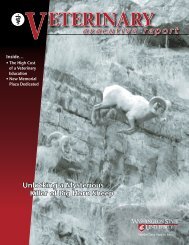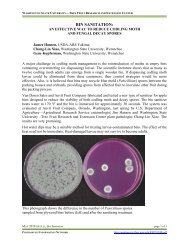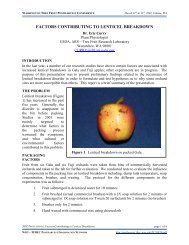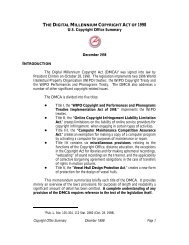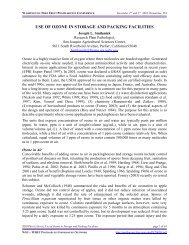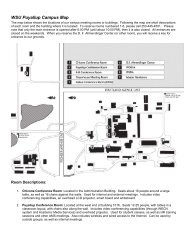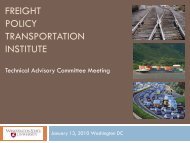Spring/Summer 2010 - College of Veterinary Medicine - Washington ...
Spring/Summer 2010 - College of Veterinary Medicine - Washington ...
Spring/Summer 2010 - College of Veterinary Medicine - Washington ...
Create successful ePaper yourself
Turn your PDF publications into a flip-book with our unique Google optimized e-Paper software.
<strong>Veterinary</strong><br />
executive report<br />
Dr. Boel Fransson,<br />
director <strong>of</strong> the<br />
VALT lab<br />
<strong>Spring</strong>/<strong>Summer</strong> <strong>2010</strong><br />
VALT WSU’s<br />
<strong>Veterinary</strong>Applied<br />
Laparoscopic<br />
Training Laboratory<br />
How Virtual Reality is Changing<br />
<strong>Veterinary</strong> <strong>Medicine</strong>
Message from the Dean<br />
It is always an honor to recognize some <strong>of</strong> the best and brightest alumni <strong>of</strong> the<br />
WSU <strong>College</strong> <strong>of</strong> <strong>Veterinary</strong> <strong>Medicine</strong>. This year, four very special alumni received the<br />
Distinguished <strong>Veterinary</strong> Alumnus Award for excellence in research and teaching or<br />
veterinary practice.<br />
Dean Bryan Slinker<br />
<strong>Veterinary</strong> Executive Report<br />
WSU <strong>College</strong> <strong>of</strong> <strong>Veterinary</strong> <strong>Medicine</strong><br />
Marcia Hill Gossard<br />
Editor and writer,<br />
mgossard@vetmed.wsu.edu<br />
Charlie Powell<br />
Co-editor and writer,<br />
(509) 335-7073, cpowell@vetmed.wsu.edu<br />
Contributing Writers<br />
Dr. Bryan Slinker,<br />
Dean <strong>of</strong> the college<br />
Dr. Richard DeBowes,<br />
Associate Dean,<br />
<strong>Veterinary</strong> Development and<br />
External Relations (VDER)<br />
Lynne Haley,<br />
Director <strong>of</strong> Development<br />
Andrea Farmer,<br />
Associate Director <strong>of</strong> Development<br />
<strong>Veterinary</strong> Development and<br />
External Relations<br />
WSU <strong>College</strong> <strong>of</strong> <strong>Veterinary</strong> <strong>Medicine</strong><br />
PO Box 647010<br />
Pullman, WA 99164-7010<br />
(509) 335-9515<br />
www.vetmed.wsu.edu<br />
Find us on Facebook and Twitter<br />
by visiting our website.<br />
The <strong>Veterinary</strong> Executive Report is published<br />
three times a year by the <strong>College</strong> <strong>of</strong> <strong>Veterinary</strong><br />
<strong>Medicine</strong> at <strong>Washington</strong> State University.<br />
Issue # 23<br />
Cert no. SW-COC-003052<br />
5/10 131507<br />
Dr. Lance Perryman (’70, ’75) and Dr. Susan Stover (’76) were the <strong>2010</strong> recipients<br />
<strong>of</strong> the Distinguished <strong>Veterinary</strong> Alumnus Award for Excellence in Teaching and<br />
Research. Dr. Perryman has been a leader in enhancing the quality <strong>of</strong> veterinary<br />
medical education. Over his career he has mentored students and worked collaboratively<br />
with colleagues and led by example. I have known Lance since I was a student<br />
here and have always valued him as a mentor and friend. Dr. Perryman is currently<br />
dean <strong>of</strong> the <strong>College</strong> <strong>of</strong> <strong>Veterinary</strong> <strong>Medicine</strong> and Biomedical Sciences at Colorado<br />
State University. However, he has no choice but to be a Coug, having received both<br />
his DVM and Ph.D. degrees here and having spent the first 20 years <strong>of</strong> his teaching,<br />
research, and academic administration career in our college.<br />
Dr. Stover is an outstanding teacher and an excellent role model for students.<br />
Recently, she mentored two students who received the 2008 and 2009 James<br />
Wilson Award for Best Equine Publication by a resident or graduate student. She<br />
also leads an internationally recognized research program for the study <strong>of</strong> equine<br />
racing injuries, and has testified before the U.S. Senate subcommittee on catastrophic<br />
racing injuries.<br />
Dr. Thomas Meyer (’78) and Dr. Charles Sedgwick (’57) received the <strong>2010</strong><br />
Distinguished <strong>Veterinary</strong> Alumnus Award for Excellence in Practice. Dr. Meyer<br />
and his wife Dr. Jean Meyer opened the Mountain View <strong>Veterinary</strong> Hospital in<br />
Vancouver, Wash., where they have practiced for over 20 years. Dr. Meyer has a deep<br />
understanding <strong>of</strong> veterinary medicine and has been a strong supporter <strong>of</strong> our college<br />
through his engagement with the <strong>Washington</strong> State <strong>Veterinary</strong> Medical Association<br />
and the American <strong>Veterinary</strong> Medical Association, giving generously <strong>of</strong> his time and<br />
knowledge to advance our pr<strong>of</strong>ession.<br />
Dr. Sedgwick, who has worked in some <strong>of</strong> the nation’s top zoos, has devoted his<br />
career to zoo medicine and to improving the lives <strong>of</strong> zoo animals. Over the years,<br />
Dr. Sedgwick has helped improve<br />
anesthesiology procedures,<br />
animal facilities, and other aspects<br />
<strong>of</strong> animal care in order to enhance<br />
the well-being <strong>of</strong> animals living<br />
in zoos.<br />
I’m pleased to share with you<br />
the very brief but illustrative<br />
credentials <strong>of</strong> these outstanding<br />
WSU Cougar alumni.<br />
Go Cougs!<br />
The Awards<br />
The college’s Distinguished <strong>Veterinary</strong> Alumnus<br />
Award is given to honor DVM graduates for veterinary<br />
excellence in practice or teaching and research.<br />
The Distinguished <strong>Veterinary</strong> Graduate Alumnus<br />
Award is given to honor M.S. or Ph.D. graduates for<br />
excellence in research, teaching, service, or business.<br />
[not awarded in <strong>2010</strong>]<br />
The Outstanding Service Award is given to an<br />
individual who has made extraordinary contributions<br />
to animals and/or the WSU <strong>College</strong> <strong>of</strong> <strong>Veterinary</strong><br />
<strong>Medicine</strong>. Individuals need not be an alumnus <strong>of</strong> the<br />
college to be nominated. [not awarded in <strong>2010</strong>]<br />
To learn more about the awards, please visit<br />
www.vetmed.wsu.edu/Awards. Nomination<br />
deadline for 2011 is February 4.<br />
2 | <strong>Veterinary</strong> Executive Report
<strong>2010</strong> Distinguished <strong>Veterinary</strong><br />
Alumnus Award for Excellence in<br />
Teaching and Research<br />
Dr. Lance Perryman (’70 DVM, ’75 Ph.D.)<br />
is currently the dean <strong>of</strong> the <strong>College</strong> <strong>of</strong> <strong>Veterinary</strong><br />
<strong>Medicine</strong> and Biomedical Sciences at Colorado<br />
State University in Fort Collins. He also<br />
serves as the executive dean to the President’s<br />
Cabinet. Dr. Perryman first came to WSU in<br />
1964 as an undergraduate and began the DVM<br />
curriculum in the fall <strong>of</strong> 1966. In 1968, he was<br />
an NIH predoctoral fellow in the WSU Department<br />
<strong>of</strong> <strong>Veterinary</strong> Pathology. After receiving<br />
his DVM and Ph.D. at WSU, Dr. Perryman Dr. Lance Perryman<br />
served as a pr<strong>of</strong>essor and later the director <strong>of</strong><br />
the Animal Health Research Center at the WSU until 1994. That year<br />
he took a post as head <strong>of</strong> the Department <strong>of</strong> Microbiology, Pathology,<br />
and Parasitology at the <strong>College</strong> <strong>of</strong> <strong>Veterinary</strong> <strong>Medicine</strong> at North<br />
Carolina State University in Raleigh. He has published more than<br />
140 refereed scientific publications.<br />
Dr. Susan Stover<br />
Dr. Susan Stover (’76) is currently a<br />
pr<strong>of</strong>essor in the Department <strong>of</strong> Anatomy,<br />
Physiology, and Cell Biology at the<br />
University <strong>of</strong> California, Davis. She has<br />
an internationally recognized program in<br />
equine racing injuries, and her research<br />
has helped inform policy changes improving<br />
the welfare <strong>of</strong> racing horses. She was<br />
the 2007 recipient <strong>of</strong> the Faculty Research<br />
Award at UC-Davis School <strong>of</strong> <strong>Veterinary</strong><br />
<strong>Medicine</strong>. In 2008 she was selected as an<br />
Outstanding Woman in Racing by the California<br />
Thoroughbred Breeders Association.<br />
<strong>2010</strong> Distinguished <strong>Veterinary</strong><br />
Alumnus Award for<br />
Excellence in Practice<br />
Dr. Thomas Meyer (’78) and his wife Dr. Jean<br />
Meyer established the Mountain View <strong>Veterinary</strong><br />
Hospital <strong>of</strong> Vancouver, Wash. in 1979. In 2004,<br />
he received the Veterinarian <strong>of</strong> the Year Award<br />
from the <strong>Washington</strong> State <strong>Veterinary</strong> Medical<br />
Association (WSVMA). Dr. Meyer chaired the<br />
American <strong>Veterinary</strong> Medical Association (AVMA)<br />
House Advisory Committee from 2002 to 2003<br />
and has served in the AVMA House <strong>of</strong> Delegates<br />
since 1995. Because <strong>of</strong> his interest in leadership<br />
development, Dr. Meyer is an advocate for Dr. Thomas Meyer<br />
the <strong>Veterinary</strong> Leadership Experience (VLE), an<br />
experiential leadership program for students and faculty that teaches life<br />
skills in better communication and collaboration with one another.<br />
After Dr. Charles Sedgwick (’57) graduated<br />
from WSU, he went on to have a distinguished<br />
career in zoo medicine. Dr. Segewick has worked<br />
in some <strong>of</strong> the nation’s top zoos including the San<br />
Diego Zoo and the Sacramento Zoo, where he was<br />
the director <strong>of</strong> veterinary services. Most recently<br />
he served as chief zoological veterinarian at the<br />
Los Angeles Zoo. He has held posts at the<br />
University <strong>of</strong> California, Davis, Tufts University,<br />
and was the project veterinarian for Biosatellite<br />
(monkeys in space) at the University <strong>of</strong> California,<br />
Dr. Charles Sedgwick<br />
Los Angeles. He is currently a consultant in zoo<br />
medicine. In 2008, Dr. Sedgwick was honored<br />
with a lifetime achievement award from the American Association <strong>of</strong><br />
Zoo Veterinarians.<br />
WSU’s New <strong>Veterinary</strong><br />
Specialty Teaching Clinic<br />
The WSU <strong>Veterinary</strong> Specialty Teaching Clinic in<br />
Spokane, Wash. held its grand opening February 19, <strong>2010</strong>.<br />
The clinic, located on WSU’s Riverpoint Campus, is a satellite<br />
facility supporting clinical teaching<br />
and training for WSU’s veterinary<br />
program. The facility also serves the<br />
specialist referral needs <strong>of</strong> the greater<br />
Spokane area veterinary community.<br />
A long-time veterinary ophthalmologist<br />
and owner <strong>of</strong> the Animal<br />
Eye Clinic <strong>of</strong> Spokane, Dr. Bill Yakely<br />
will continue his practice within the<br />
new facility with his current staff.<br />
WSU veterinary students will be<br />
accepted by the practice for ophthalmological<br />
training.<br />
“It is a very important and costeffective<br />
benefit for us to have Dr.<br />
Yakely and his staff continue to train our students,” said<br />
Dr. Bryan Slinker, dean <strong>of</strong> the college. “His affiliation with<br />
teaching ophthalmology in this college extends over many<br />
years and we are very grateful.”<br />
Spokane Specialty Clinic Ribbon Cutting<br />
(from l-r) Rich Hadley <strong>of</strong> Greater Spokane Inc.,<br />
Provost Warwick Bayly, Dr. Bill Dernell,<br />
Dean Bryan Slinker, and Dr. Harmon Rogers.<br />
The WSU <strong>Veterinary</strong> Specialty Teaching<br />
Clinic in Spokane.<br />
The WSU <strong>Veterinary</strong> Specialty<br />
Teaching Clinic is located in a recently<br />
renovated building on the WSU Spokane<br />
campus. The development and operation<br />
<strong>of</strong> the clinic are aided by a $2.7 million<br />
estate gift from WSU veterinary alumnus<br />
Dr. Bernard Pinckney (’44). It was Dr.<br />
Pinckney’s wish that his gift be used to<br />
establish a satellite clinic to <strong>of</strong>fer continuing<br />
education opportunities for students<br />
and practitioners. The clinic is also<br />
supported by a second generous bequest<br />
<strong>of</strong> nearly $1 million from the Charlotte Hays estate. Hays, <strong>of</strong><br />
Richland, <strong>Washington</strong>, had a special bond with her animals<br />
throughout her life to which the gift pays tribute.<br />
<strong>Veterinary</strong> Executive Report | 3
How Virtual Reality is Changing<br />
<strong>Veterinary</strong> <strong>Medicine</strong><br />
In a small, windowless room, four veterinarians simultaneously<br />
tie sutures, biopsy a liver, and perform minimally invasive<br />
abdominal surgery. No, this is not a typical operating room. It<br />
is a veterinary laparoscopic training laboratory—the first <strong>of</strong> its<br />
kind in the nation.<br />
Nearly four years ago, Dr. Boel Fransson, a board-certified<br />
small animal surgeon, designed what is now the <strong>Veterinary</strong><br />
Applied Laparoscopic Training (VALT) laboratory at<br />
<strong>Washington</strong> State University. Although laparoscopic simulation<br />
training has been widely used in human medicine for more<br />
than a decade, similar training had not been available in animal<br />
medicine. A laparoscope is essentially a telescope used by<br />
surgeons to see inside body cavities while doing minimally<br />
invasive surgery through tiny incisions, <strong>of</strong>ten called keyholes.<br />
“Our laboratory is the first in the country to develop veterinary<br />
simulation training in laparoscopic surgery,” said Dr. Boel<br />
Fransson, director <strong>of</strong> the VALT laboratory. “I was very interested<br />
in technique development for the additional skills required for<br />
the minimally invasive surgeries we perform in clinical practice<br />
here at WSU.”<br />
Laparoscopic surgery is being<br />
used more <strong>of</strong>ten in veterinary medicine<br />
because <strong>of</strong> the same advantages<br />
to patients as seen in humans. Risks<br />
associated with traditional open<br />
surgery are minimized, pain is<br />
reduced and easier to control, and<br />
patients <strong>of</strong>ten recover much more<br />
quickly. It is also a valuable tool that<br />
Dr. Boel Fransson, WSU small animal surgeon and VALT lab director,<br />
works on a training box that teaches hand-eye coordination skills<br />
needed to perform laparoscopic surgery and diagnostics.<br />
4 | <strong>Veterinary</strong> Executive Report<br />
“We want to train better and<br />
safer surgeons.”<br />
—Dr. Boel Fransson, WSU veterinary<br />
surgeon and director <strong>of</strong> the<br />
VALT laboratory<br />
(l-r) A box trainer uses real instruments<br />
to teach hand-eye coordination and<br />
practice routine procedures such as<br />
suturing. The virtual reality trainer<br />
uses a large screen and gives instant<br />
feedback. The canine abdomen models<br />
allow surgeons to feel the confinement<br />
and shape <strong>of</strong> the abdominal cavity.<br />
allows veterinarians<br />
to run diagnostic tests<br />
they may not otherwise<br />
be able to perform.<br />
Although the American<br />
<strong>College</strong> <strong>of</strong> <strong>Veterinary</strong><br />
Surgeons requires<br />
training in minimally<br />
invasive surgical techniques,<br />
there was no<br />
other learning platform<br />
for surgeons in training<br />
except to participate in<br />
actual surgeries with<br />
a mentoring surgeon.<br />
Dr. Fransson and her<br />
colleague, Dr. Claude<br />
Ragle, a WSU boardcertified<br />
equine surgeon and pioneer in equine laparoscopy, believe<br />
additional training outside the operating<br />
room is necessary to achieve higher competency<br />
levels. More training also means less<br />
risk to the patients.<br />
“We want to train better and safer<br />
surgeons,” said Dr. Fransson, “before they<br />
perform surgery on someone’s beloved pet.”<br />
With proper training laparoscopic<br />
surgery can be simpler and safer than other<br />
surgical techniques. Training in the VALT<br />
lab, surgeons become accustomed to using<br />
actual surgical tools in small spaces while watching the magnified<br />
procedures on a television screen.<br />
“Training in the lab improves dexterity and familiarity,” said<br />
Dr. Courtney Watkins, a WSU small animal surgery resident who<br />
has trained in the VALT lab. “It is a good way to practice skills<br />
without the stress and urgency <strong>of</strong> an actual surgery.”<br />
Practicing the precise movements <strong>of</strong> laparoscopic surgery<br />
also helps the techniques to become second nature. Additional<br />
training minimizes unnecessary movements, surgery time, and<br />
increases accuracy.<br />
“The training builds confidence and better surgeons,” said Dr.<br />
Stavros Yiannikouris, WSU equine surgery resident. “In the VALT<br />
lab, I have the freedom to explore different surgical techniques to<br />
learn what will be most efficient and effective during surgery.”<br />
The VALT lab began training veterinarians in 2008 with very<br />
basic equipment, such as a box trainer that uses real instruments<br />
to teach hand-eye coordination necessary for routine procedures<br />
such as suturing. Dr. Fransson later added canine abdomen models<br />
that train surgeons in the feel and size <strong>of</strong> the abdominal cavity and<br />
organs. The virtual reality, or VR, trainer was added to the lab earlier<br />
this year.<br />
“The virtual laparoscopic trainer has a real feel,” said Dr. Ragle,<br />
WSU equine surgeon and VALT lab co-director. “It provides immediate<br />
feedback by showing if you’ve made a patient bleed or if you are<br />
going out <strong>of</strong> bounds.”
To learn more about the VALT<br />
laboratory and simulated<br />
laparoscopic surgery at WSU,<br />
please visit www.vetmed.wsu.<br />
edu/VALT.<br />
After working on the<br />
VR trainer, surgeons receive<br />
printouts to learn how their<br />
techniques can be more efficient<br />
and safe. The s<strong>of</strong>tware<br />
tracks the surgeon’s performance<br />
and provides an<br />
assessment <strong>of</strong> the surgeon’s<br />
skills.<br />
“Sometimes it is that the<br />
tools need to be adjusted,<br />
or it could be how the<br />
surgeon is standing or even<br />
holding their arms that<br />
makes a difference,” said<br />
Dr. Ragle.<br />
One <strong>of</strong> the criticisms <strong>of</strong> virtual reality<br />
trainers is that they do not provide physical,<br />
or haptic, feedback that a surgeon would feel<br />
during an actual surgery. Although the canine<br />
abdomen model does provide some haptic feedback,<br />
the VALT lab will also be adding an<br />
augmented reality trainer, a hybrid that combines<br />
virtual reality with haptic feedback. As the<br />
lab grows, Dr. Fransson would like to expand<br />
training to more veterinarians.<br />
“Currently we are training residents and<br />
veterinarians at WSU in our lab,” said Dr.<br />
Fransson. “Our plan is to open it up to DVM<br />
students as an elective. We hope in the<br />
Dr. Claude Ragle, left, a WSU equine surgeon and co-director <strong>of</strong><br />
the VALT lab, and Dr. Courtney Watkins, WSU small animal<br />
surgery resident, work on the virtual reality trainer. The trainer<br />
provides immediate feedback to surgeons.<br />
future to even invite surgeons from<br />
other universities to come train in<br />
our lab.”<br />
Since Dr. Fransson has begun training<br />
in the VALT lab, WSU veterinarians<br />
have gone from having basic skills in<br />
laparoscopic surgery to now being at<br />
the highest competency level.<br />
“By having everyone trained at this<br />
level, it has increased the safety for our<br />
patients,” said Dr. Fransson. “Increasing<br />
safety means we are <strong>of</strong>fering the best<br />
possible care.”<br />
The VALT Laboratory<br />
at WSU<br />
Established in 2008, the VALT<br />
laboratory’s mission is to develop,<br />
validate, and implement veterinary<br />
laparoscopic training programs.<br />
The aim is to bring basic<br />
laparoscopic skills training out <strong>of</strong><br />
the operating room, where<br />
different techniques can be<br />
practiced and explored. The<br />
long-term goal is to create safer<br />
surgeons for the benefit <strong>of</strong><br />
animal patients.<br />
Unlike traditional surgical<br />
techniques, laparoscopic surgery<br />
can be performed using very small<br />
incisions. With minimally invasive<br />
procedures, there are fewer risks<br />
for the patient and recovery time<br />
is much quicker. Also sometimes<br />
called keyhole surgery, surgeons<br />
look at magnified images on<br />
television screens while using long<br />
instruments to perform the surgery<br />
or diagnostic procedures. Because<br />
a very different skill set is used in<br />
laparoscopic surgeries, additional<br />
training in the VALT lab has shown<br />
in research studies to improve<br />
skill levels.<br />
Dr. Stavros Yiannikouris, WSU<br />
equine surgery resident and<br />
Dr. Boel Fransson, WSU small<br />
animal surgeon and VALT<br />
director, use canine abdomen<br />
models that give an accurate feel<br />
<strong>of</strong> the size and space <strong>of</strong> a real<br />
laparoscopic surgery.<br />
<strong>Veterinary</strong> Executive Report | 5
From the Office <strong>of</strong> Development and<br />
External Relations<br />
On March 21, several members<br />
from the college spent a<br />
fantastic spring day with our<br />
good friends and teaching hospital<br />
clients, Dave and Eddylee<br />
Scott and their beloved dog,<br />
“Cassie.” The Scotts and their<br />
Dr. Richard DeBowes,<br />
friends hosted a fundraiser for<br />
Associate Dean <strong>of</strong><br />
<strong>Veterinary</strong> Development the WSU <strong>Veterinary</strong> Teaching<br />
and External Relations Hospital at Hellams Vineyard<br />
in La Conner, Wash. Cassie,<br />
a cancer survivor, came to the teaching hospital in the summer<br />
<strong>of</strong> 2008 after the Scotts found a lump on the top <strong>of</strong> her<br />
head (see Cassie’s Story). As a way to give back to the teaching<br />
hospital and honor the wonderful veterinary team they<br />
worked with in Pullman, the Scotts planned this spectacular<br />
event where friends could gather to learn about the good<br />
work being done at the college. Guests enjoyed good food,<br />
great wine, a silent auction, raffle, and presentations by Dr.<br />
Jeffrey Bryan, a WSU veterinary oncologist, and Dr. Annie<br />
Chen-Allen, a WSU veterinary neurologist, and me.<br />
It seems alumni and clients are asking us more <strong>of</strong>ten how<br />
they can help us move the college and its programs forward.<br />
One approach is typified by the generous actions <strong>of</strong> the<br />
Scotts—a reception held by grateful clients or caring veterinary<br />
alums inviting friends and key clients to learn more<br />
about the pr<strong>of</strong>ession and their preferred college <strong>of</strong> veterinary<br />
medicine. Although the needs for program, infrastructure,<br />
and student support are considerable, with the generous support<br />
<strong>of</strong> alumni and friends we can meet our goals. Alumni<br />
and friends <strong>of</strong> the college who are interested in helping us<br />
meet new friends and network more broadly with potential<br />
donors should feel welcome to make their thoughts known<br />
to any member <strong>of</strong> the WSU <strong>College</strong> <strong>of</strong> <strong>Veterinary</strong> <strong>Medicine</strong><br />
development team.<br />
We had a wonderful time visiting with some old friends<br />
<strong>of</strong> the college, and making some new ones. Heartfelt thanks<br />
to the Scotts, Hellams, and the countless volunteers for all<br />
the generous support we’ve received.<br />
Cassie’s Story<br />
In the summer <strong>of</strong> 2008, while fishing near Juneau, Alaska,<br />
Dave and Eddylee Scott found a lump on the top <strong>of</strong> their 7-yearold<br />
Golden Retriever’s head. They made a quick call back home<br />
to their veterinarian, Dr. Lance<br />
Campbell (’99), who advised<br />
them to take “Cassie” to a<br />
clinic in Juneau and have the<br />
lump removed. The Southeast<br />
Alaska Animal Medical Center<br />
removed the tumor—a benign<br />
multilobular tumor <strong>of</strong> the<br />
bone—but within 3 weeks the<br />
tumor returned.<br />
Dave and Eddylee Scott, Heather<br />
On the advice <strong>of</strong> Dr. Campbell,<br />
they traveled to Washing-<br />
Davis (’09) and “Cassie”<br />
ton State University’s <strong>Veterinary</strong> Teaching Hospital in Pullman,<br />
Wash. An MRI showed the tumor was growing from Cassie’s<br />
skull and pressing on her brain. Dr. Jeffrey Bryan, a boardcertified<br />
veterinary oncologist, organized a treatment plan for<br />
Cassie in conjunction with the neurology service and radiation<br />
oncology. After seven hours <strong>of</strong> surgery, and a course <strong>of</strong> radiation<br />
therapy that included 20 daily sessions, Cassie spent 10 months<br />
enjoying life with Dave and Eddylee as they boated and played<br />
golf. Her follow-up required only periodic exams.<br />
The following June, an MRI revealed regrowth <strong>of</strong> the mass.<br />
With all standard options exhausted, Cassie required a creative<br />
plan for further treatment. Following three more doses <strong>of</strong> radiation,<br />
she received a radioactive drug (radiopharmaceutical) to<br />
deliver a strong dose <strong>of</strong> radiation directly to the tumor through<br />
her bloodstream in August 2009. She was the first dog in <strong>Washington</strong><br />
to ever receive this type <strong>of</strong> drug. Cassie began a Palladia<br />
(toceranib phosphate) regimen, a new cancer drug therapy, and<br />
pamidronate, an osteoporosis treatment, in September 2009.<br />
These new therapies combined to keep her symptom-free and<br />
enjoying life.<br />
“Cassie is a great dog owned by a fantastic couple,” said Dr.<br />
Bryan. “Our hope here is that we can provide palliative care and<br />
maintain her quality <strong>of</strong> life.”<br />
Editor’s note: After this story was written, Cassie lost her<br />
nearly two-year battle with cancer. “Our goal all along was to<br />
keep her happy and comfortable,” said Dr. Jeffrey Bryan, WSU<br />
veterinary oncologist. “She broke new ground that will benefit<br />
future dogs in <strong>Washington</strong>, wagging her tail the whole time.”<br />
To read more about Cassie on our Pet Memorial website visit<br />
www.vetmed.wsu.edu/PetMemorial<br />
6 | <strong>Veterinary</strong> Executive Report
Awards and Achievements<br />
Dr. Guy H. Palmer,<br />
<strong>Washington</strong> State<br />
University Regents<br />
Pr<strong>of</strong>essor <strong>of</strong> pathology<br />
and director <strong>of</strong> WSU’s<br />
School for Global Animal<br />
Health, has been<br />
awarded $3.4 million<br />
from the National Institutes<br />
<strong>of</strong> Health (NIH). The funding comes<br />
in the form <strong>of</strong> a highly competitive MERIT<br />
(Method to Extend Research in Time) Award<br />
through the NIH’s Division <strong>of</strong> Microbiology<br />
and Infectious Diseases <strong>of</strong> the National Institutes<br />
<strong>of</strong> Allergy and Infectious Diseases.<br />
Dr. Mushtaq Memon,<br />
associate pr<strong>of</strong>essor in<br />
WSU’s <strong>Veterinary</strong> Clinical<br />
Sciences department<br />
and the School for<br />
Global Animal Health,<br />
is the first veterinarian<br />
to be selected as a Fulbright<br />
Ambassador. The<br />
Fulbright Ambassador Program invites Fulbright<br />
scholar alumni to serve as representatives<br />
at campus workshops and academic<br />
conferences across the United States.<br />
Regents Pr<strong>of</strong>essor Dr.<br />
James M. Krueger<br />
received the <strong>2010</strong> Eminent<br />
Faculty Award from<br />
<strong>Washington</strong> State University.<br />
A neuroscience<br />
pr<strong>of</strong>essor in <strong>Veterinary</strong> and<br />
Comparative Anatomy,<br />
Pharmacology, and Physiology,<br />
Krueger was honored during the annual<br />
Showcase celebration on March 26, <strong>2010</strong>. The<br />
Eminent Faculty Award, the highest honor<br />
bestowed by WSU upon faculty, was created in<br />
2000 to honor career-long excellence within<br />
WSU’s academic community.<br />
From left, Dean Bryan Slinker and<br />
Dr. Stephen Withrow<br />
Dr. Stephen J. Withrow received the<br />
<strong>2010</strong> McCoy Award. Dr. Withrow is a<br />
pr<strong>of</strong>essor <strong>of</strong> surgical oncology and director<br />
<strong>of</strong> the Animal Cancer Center at Colorado<br />
State University’s <strong>College</strong> <strong>of</strong> <strong>Veterinary</strong><br />
<strong>Medicine</strong> and Biomedical Sciences. He is a<br />
Diplomate <strong>of</strong> the American <strong>College</strong> <strong>of</strong> <strong>Veterinary</strong><br />
Surgeons and the American <strong>College</strong><br />
<strong>of</strong> <strong>Veterinary</strong> Internal <strong>Medicine</strong> (oncology).<br />
The John E. McCoy Award is one <strong>of</strong> the<br />
most prestigious awards given by the WSU<br />
<strong>College</strong> <strong>of</strong> <strong>Veterinary</strong> <strong>Medicine</strong>. During his<br />
23 year teaching career at WSU, Dr. McCoy<br />
served as chair <strong>of</strong> the WSU <strong>Veterinary</strong> Clinic<br />
and dean <strong>of</strong> the college.<br />
Dr. Tom Besser received<br />
a 3-year USDA grant to<br />
find genetic markers that<br />
identify five newly identified<br />
strains <strong>of</strong> E. coli O157.<br />
The markers will differentiate<br />
strains that cause<br />
human disease from strains<br />
that infect cattle, but not<br />
humans. Researchers will use the markers to<br />
evaluate the treatment effectiveness for the different<br />
strain types. The grant will also support<br />
an outreach program aimed at improving the<br />
accuracy <strong>of</strong> E. coli O157 information presented<br />
to industry, health pr<strong>of</strong>essionals, the media,<br />
and policy makers.<br />
Lynne Haley,<br />
Director <strong>of</strong> Development<br />
Your Gifts<br />
in Action<br />
Patients at WSU’s <strong>Veterinary</strong><br />
Teaching Hospital can now receive<br />
on-location cardiovascular diagnosis<br />
thanks to a new portable echocardiograph<br />
from a generous friend<br />
<strong>of</strong> the college.<br />
“We are very grateful to have<br />
this machine,” said Dr. Lynne Nelson,<br />
a WSU veterinary cardiologist.<br />
“This echo is the latest, state-<strong>of</strong>-theart,<br />
portable machine. Because it is portable, we can take it to<br />
a sick horse, kitten, or any animal.”<br />
An echocardiograph is used to diagnose cardiovascular<br />
conditions in animals using ultrasonic sound waves. The<br />
machine can help visualize heart disease symptoms, measure<br />
the size and shape <strong>of</strong> the heart, and locate tissue damage.<br />
But, until now, patients<br />
had to come to the WSU<br />
<strong>Veterinary</strong> Teaching Hospital<br />
for testing. Veterinarians<br />
and technicians can<br />
bring the new portable<br />
echocardiograph to a sick<br />
or downed animal and<br />
make a diagnosis in remote<br />
locations.<br />
“It has the same<br />
quality as a larger, stand<br />
alone machine,” said<br />
Nelson. “And it is very<br />
versatile. It can be used<br />
on small exotic animals or<br />
large animals like horses.<br />
We love it.”<br />
(from l-r): biosound applications<br />
specialist Chris Ingle, WSU wildlife<br />
specialist Dr. Charlie Robbins, and<br />
WSU cardiologist Dr. Lynne Nelson<br />
use echocardiography to perform<br />
myocardial strain analysis on Kio<br />
the grizzly bear. The test gives<br />
information about different regions<br />
<strong>of</strong> Kio’s heart muscle.<br />
To learn more about how your gift<br />
can make a difference visit<br />
www.vetmed.wsu.edu/Giving.<br />
<strong>Veterinary</strong> Executive Report | 7
<strong>College</strong> <strong>of</strong> <strong>Veterinary</strong> <strong>Medicine</strong><br />
PO Box 647010<br />
Pullman, WA 99164-7010<br />
www.vetmed.wsu.edu<br />
<strong>College</strong> <strong>of</strong> <strong>Veterinary</strong> <strong>Medicine</strong><br />
PO Box 647010<br />
Pullman, WA 99164-7010<br />
Nonpr<strong>of</strong>it<br />
Organization<br />
U.S. Postage<br />
P A I D<br />
Pullman, WA<br />
Permit No. 1<br />
Look for a WSU Alumni, Friends, and Students Gathering<br />
at these Upcoming Events!<br />
Mark your calendars<br />
Peter A. Zornes Memorial<br />
Golf Tournament<br />
The third annual Peter A. Zornes Memorial Golf<br />
Tournament will be held on Saturday, June 26,<br />
<strong>2010</strong>, at the Colfax Golf Club to benefit the<br />
Peter A. Zornes Memorial Neuroscience Scholarship<br />
at <strong>Washington</strong> State University.<br />
The event includes a box lunch, a putting contest, BBQ<br />
dinner, and awards. Register at www.vetmed.wsu.edu/<br />
Zornes or contact Lynne Haley at lhaley@vetmed.wsu.edu<br />
or 509-335-5021. Remember to invite your friends to play!<br />
Other important dates to remember:<br />
July 31-August 3 AVMA in Atlanta, GA<br />
August 2 CVM Alumni Reception at AVMA in Atlanta, GA<br />
August 21 Bill Johnson’s Fourth Annual Bicycle Ride for WSU<br />
October 1–3 WSVMA in Spokane, WA<br />
October 9 CVM Homecoming BBQ (vs. Oregon)<br />
October 8-10 CVM Class Reunions (‘70, ‘80, ‘90, ’00)<br />
CE courses at WSU and online <strong>of</strong>fered year round:<br />
www.vetmed.wsu.edu/CE<br />
For more information about upcoming events<br />
visit www.vetmed.wsu.edu/Events.



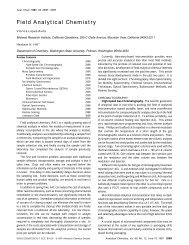
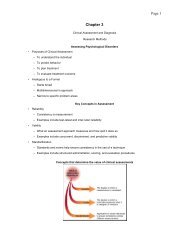
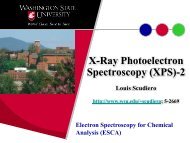
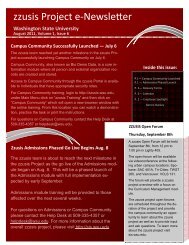
![Graduate School Policies & Procedures Manual 2011 - 2012 [PDF]](https://img.yumpu.com/50747405/1/190x245/graduate-school-policies-procedures-manual-2011-2012-pdf.jpg?quality=85)
